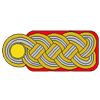The tutorial below was written with Shermans and/or Pz IV's in mind but it should be adaptable to a Whippet. Not much in the way of track sag on a Whippet (more like a Sherman than a Pz IV).
Straight sections do not need to be formed (except lying flat on the work bench), short sections, maybe 5-6 links at the most can be formed without too much problems. A whole track run sounds like a sure way to fail (except with Friuls with wire pins connecting the track links ...)
/ Robin
Once upon a time I tried to assemble one long length of track and then getting it on the tank while the glued joints were still soft enough. This is a sure way to disaster so don't even try.
Basics:
Look at the tank from the side: There is one length on the ground, flat if the "ground" is flat et.c. Then there are short lengths going up from the ground towards the idler and the drive sprocket, these can be straight, hanging down or
bent upwards/inwards depending on what the tank is doing (moving forward, backward, turning or small maneuvers). Then comes the curved bits around the idler and the sprocket. Depending on the type of track on the real vehicle the top
run is either almost totally straight or hangs down slightly. Look at images of the real thing before building, Shermans and US tanks = straight, German WWII = slight sagging, Soviet WWII significant sag. Look at images!
Use solvent glue like Humbrol Liquid Poly, do NOT use tube glue unless you are an expert in handling that stuff. Liquid glue took my modelling forward by leaps an bounds.
How to do it:
Described for one side of the tank:
Make a long flat section that goes from the middle of the first road wheel to the middle of the last road wheel. Let it dry completely. By middle of the road wheel I mean the point where it touches flat ground.
Make a long run to reach from the sprocket wheel (one tooth onto the sprocket wheel) all the way to the top of the idler wheel. For a PzIII or IV it should hang down
about the thickness of one track link (check images), on a Sherman it is straight.
Put it in position on the tank when it is still slightly soft but DO NOT glue it in place yet. Gently shape the track sagging (check images), one link should engage the sprocket and the other end bent down over the idler if the section is long enough.
Now you have the top and bottom sections of the track and need to join them.
Make a short bit (short bit A) , 3 to 4 links and shape around the sprocket wheel, three to four bits is the longest section that will still be removable from the sprocket when it is dry. Make a short bit (short bit B), 5-7 links and shape around the idler (no teeth -> longer section is possible to remove when dry) DO NOT glue to the idler yet.
Now it is time to start to start counting links for the two sections that will go up from the ground towards the sprocket and the idler. The difficult part here is to get just the right curve. These two sections is where you adjust the total length of the
track so that you don't end up with a gap shorter than one track link.
The instruction sheets for Dragon kist usually show the correct number of links.
The length (C) from the ground up to the sprocket wheel should reach 1-2 teeth onto the sprocket leaving a gap at least the length of 'short bit A' between itself and the top run. The section going up to the idler shall be made to reach from the bottom run all the way up to short bit B and short bit B shall reach the top run.
Now you have two long bits where the glue has dried (top and bottom) and two
short semi soft bits, one going between top and bottom around the idler and one
connecting the bottom bit to the sprocket wheel. Gently bend the shorter bits so that the track sits correctly. Check images. It may be necessary to give the top run a little more or a little less sag to get everything to fit, gentle force.
When everything has dried it is time to join the lengths (except short bit A) to one long deep U and make another short bit, AA, to fill in the last few links on the sprocket wheel. If you feel that this is tricky then leave the length C loose until mounting on the tank.
When all this has dried you will have three pieces: the deep U, short bit A and AA (plus possibly length C),
Time for painting, the deep U is fragile but it can still be handled if you are careful.
Paint the base colour and most of the later steps, ask the forum for hints and tips about colours and stuff. The last painting can be done with the track on the tank.
The insides, the side of the track touching the wheels, should be painted before mounting on the tank, outsides are easy to reach afterwards.
The track is mounted on the tank by pushing it on from the idler end, if you are right handed: sprocket wheel to the left, left hand holds tank, right hand holds track and pushes track to the left towards the sprocket. Fit the links over the sprocket and glue in place. By making the joins over the sprocket wheel the teeth will hold everything in place. Use very fine and thin sandpaper to remove the paint where the road wheels and return rollers touches the track and add small amounts of liquid glue. Let it dry.
Time for last paint job.














